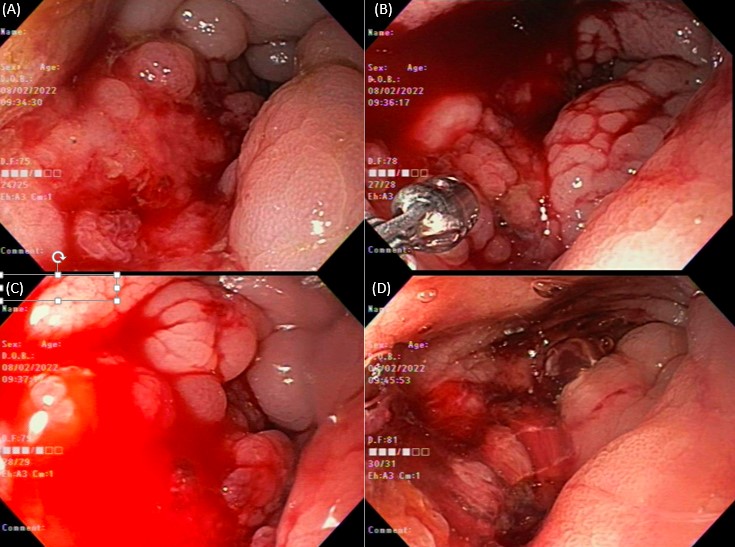Tuesday Poster Session
Category: GI Bleeding
P4232 - Hemostatic Peptides: An Effective Tool for Managing Bleeding When Traditional Options Are Challenging
Tuesday, October 29, 2024
10:30 AM - 4:00 PM ET
Location: Exhibit Hall E

Has Audio
- MT
Michael Temple, MD
Medical College of Georgia at Augusta University
Augusta, GA
Presenting Author(s)
Michael Temple, MD1, Ronan Calibuso, MD2, Viveksandeep Thoguluva Chandrasekar, MD1, Kenneth Vega, MD, FACG1, John Erikson Yap, MD, MBA, FACG3
1Medical College of Georgia at Augusta University, Augusta, GA; 2Jersey City, NJ; 3Metrodora Institute, West Valley City, UT
Introduction: Endoscopic management of gastrointestinal (GI) bleeding has significantly advanced with the incorporation of various hemostatic devices, including mechanical clips, bands, thermocoagulation, and injection therapies. These traditional methods have been complemented by newer modalities, such as hemostatic sprays and fully synthetic hemostatic gels, broadening the treatment options for previously challenging GI bleeds. PuraStat® (3-D Matrix Medical Technology, Boston, MA) is one such novel device, consisting of a 16-amino acid peptide solution that self-assembles at physiological pH to form a hydrogel composed of nanofiber networks. This hydrogel rapidly seals open blood vessels upon contact with blood or tissue fluids, while its transparency allows for direct visualization during endoscopically obtained hemostasis. We present a case where this innovative hemostatic modality was successfully employed, achieving hemostasis where use of conventional methods may have failed.
Case Description/Methods: An 82-year-old man with a past medical history of atrial fibrillation on anticoagulation, diabetes mellitus, hypertension, and prostate cancer treated 15 years ago with local radiation presented to the emergency department with a one-week history of right-sided chest pain and two days of painless bright red blood per rectum. He had no prior history of gastrointestinal bleeding, and recent prostate-specific antigen levels were within normal limits. A CT scan of the abdomen revealed an enlarged prostate invading the rectosigmoid colon and metastatic bone lesions. Gastroenterology was consulted for evaluation of hematochezia and acute hemorrhagic anemia. The patient’s vital signs and physical examination were unremarkable. Esophagogastroduodenoscopy revealed no bleeding source. Flexible sigmoidoscopy identified a 5 x 3 cm edematous, friable rectal mass suggestive of malignancy. Multiple biopsies were obtained for pathology. The biopsied mass continued to ooze, necessitating topical treatment with a synthetic peptide solution, which achieved immediate hemostasis. No further bleeding was noted post-procedure.
Discussion: This case highlights the potential of hemostatic peptide agents as an effective option for achieving hemostasis following endoscopic biopsy of friable and oozing lesions, similar to the rectal mass encountered. The device demonstrates significant promise as a crucial modality for obtaining hemostasis in lesions with limited endoscopic therapeutic options.

Disclosures:
Michael Temple, MD1, Ronan Calibuso, MD2, Viveksandeep Thoguluva Chandrasekar, MD1, Kenneth Vega, MD, FACG1, John Erikson Yap, MD, MBA, FACG3. P4232 - Hemostatic Peptides: An Effective Tool for Managing Bleeding When Traditional Options Are Challenging, ACG 2024 Annual Scientific Meeting Abstracts. Philadelphia, PA: American College of Gastroenterology.
1Medical College of Georgia at Augusta University, Augusta, GA; 2Jersey City, NJ; 3Metrodora Institute, West Valley City, UT
Introduction: Endoscopic management of gastrointestinal (GI) bleeding has significantly advanced with the incorporation of various hemostatic devices, including mechanical clips, bands, thermocoagulation, and injection therapies. These traditional methods have been complemented by newer modalities, such as hemostatic sprays and fully synthetic hemostatic gels, broadening the treatment options for previously challenging GI bleeds. PuraStat® (3-D Matrix Medical Technology, Boston, MA) is one such novel device, consisting of a 16-amino acid peptide solution that self-assembles at physiological pH to form a hydrogel composed of nanofiber networks. This hydrogel rapidly seals open blood vessels upon contact with blood or tissue fluids, while its transparency allows for direct visualization during endoscopically obtained hemostasis. We present a case where this innovative hemostatic modality was successfully employed, achieving hemostasis where use of conventional methods may have failed.
Case Description/Methods: An 82-year-old man with a past medical history of atrial fibrillation on anticoagulation, diabetes mellitus, hypertension, and prostate cancer treated 15 years ago with local radiation presented to the emergency department with a one-week history of right-sided chest pain and two days of painless bright red blood per rectum. He had no prior history of gastrointestinal bleeding, and recent prostate-specific antigen levels were within normal limits. A CT scan of the abdomen revealed an enlarged prostate invading the rectosigmoid colon and metastatic bone lesions. Gastroenterology was consulted for evaluation of hematochezia and acute hemorrhagic anemia. The patient’s vital signs and physical examination were unremarkable. Esophagogastroduodenoscopy revealed no bleeding source. Flexible sigmoidoscopy identified a 5 x 3 cm edematous, friable rectal mass suggestive of malignancy. Multiple biopsies were obtained for pathology. The biopsied mass continued to ooze, necessitating topical treatment with a synthetic peptide solution, which achieved immediate hemostasis. No further bleeding was noted post-procedure.
Discussion: This case highlights the potential of hemostatic peptide agents as an effective option for achieving hemostasis following endoscopic biopsy of friable and oozing lesions, similar to the rectal mass encountered. The device demonstrates significant promise as a crucial modality for obtaining hemostasis in lesions with limited endoscopic therapeutic options.

Figure: Figure 1A: Flexible Sigmoidoscopy showing a 5 x 3 cm edematous friable rectal mass. Figure 1B: Endoscopic biopsy of the mass. Figure 1C: Biopsied mass continuing to ooze. Figure 1D: Topically applied with instant hemostasis achieved.
Disclosures:
Michael Temple indicated no relevant financial relationships.
Ronan Calibuso indicated no relevant financial relationships.
Viveksandeep Thoguluva Chandrasekar indicated no relevant financial relationships.
Kenneth Vega indicated no relevant financial relationships.
John Erikson Yap indicated no relevant financial relationships.
Michael Temple, MD1, Ronan Calibuso, MD2, Viveksandeep Thoguluva Chandrasekar, MD1, Kenneth Vega, MD, FACG1, John Erikson Yap, MD, MBA, FACG3. P4232 - Hemostatic Peptides: An Effective Tool for Managing Bleeding When Traditional Options Are Challenging, ACG 2024 Annual Scientific Meeting Abstracts. Philadelphia, PA: American College of Gastroenterology.
